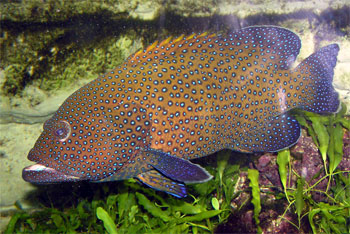Moray eels and groupers hunt together
Moray eels and groupers hunt together
mongabay.com
December 4, 2006
Moray eels and groupers hunt together according to research published in the December 5 issue of PLoS Biology.
A team of researchers lead by Redouan Bshary, a biologist at the University of Neuchâtel in Switzerland, found that moray eels and groupers practice cooperative hunting in Red Sea coral reefs — behavior not before described outside primates and birds.
The hunting habits of groupers, which are diurnal (day-active) predators that hunt in open water, are markedly different from moral eels, which are evasive nocturnal hunters that sneak through reef crevices in an attempt to ambush and corner prey. As such prey have distinctly different evasive behavior when confronted by groupers versus morays.

Blue-spotted grouper (Cephalopholis argus) at Bristol Zoo, Bristol, England. Photographed by Adrian Pingstone in May 2005.
|
“In order to avoid predatory groupers, reef fish hide in corals… Moray eels, in contrast, sneak through crevices in the reef and attempt to corner their prey in holes. Consequently, the best strategy for prey to adopt in order to avoid moray predation is to swim into open water,” write the authors. “The hunting strategies of the two predators are therefore complementary, and a coordinated hunt between individuals of the two species confronts prey with a multipredator attack that is difficult to avoid; prey are not safe in open water because of the grouper hunting strategy but cannot hide in crevices because of the moray’s mode of attack.”
The researchers indeed observed this coordinated hunting strategy.
“Groupers actively visit moray eels at their resting places and make use of visual signals to engage morays in a joint hunt. This involves shaking the head at high frequency (3—6 shakes per second) directly in front of the moray eel, usually few centimetres away from the moray’s head,” report the scientists.
The morays respond to the signal by leaving their crevice to join the grouper in swimming through the reef. The researchers never observed a moray signaling to groupers.
Both morays and groups appeared to benefit from the coordination, with each species achieving greater hunting success than when hunting alone. Groupers were even observed guiding moral eels to prey hidden in crevices.
The researchers summarize their findings as follows:
-
We found the following: (1) individual groupers and moray eels frequently spent more time in association than predicted by a null model of chance encounters, (2) groupers actively signaled to elicit joint hunting and to recruit moray eels, (3) satiated groupers did not signal, and (4) both partner species increased their hunting success in association.
“Given that moray eels showed a higher success rate than groupers in association… and only caught fish with groupers during daytime, we can at least conclude that moray eels broaden their hunting activity to daylight hours due to their interactions with groupers,” they wrote. “We did not detect any behaviour of either partner that might have served to increase the hunting success of the other species at the expense of its own hunting success. In other words, altruistic behaviour did not seem to occur during joint hunting events. Thus, the outcome of joint hunting between the groupers and the moray eels appears to be a by-product mutualism.”
“Each player uses only its evolved hunting strategy, and there is no pressure to learn specific new behaviours that yield advantages when they form part of a coordinated effort. In addition, both grouper and moray apparently try to maximise their individual capture rates, with mutual benefits accruing simply from the joint movements that serve to amplify their individual predation efforts. Interspecific coordinated hunting of this kind can emerge, therefore, from a simple associative learning process, whereby each species associates increased rewards with hunting in the vicinity of the other species.”
This article is based on an article, “Interspecific Communicative and Coordinated Hunting between Groupers and Giant Moray Eels in the Red Sea” publish in PLoS Biology.







